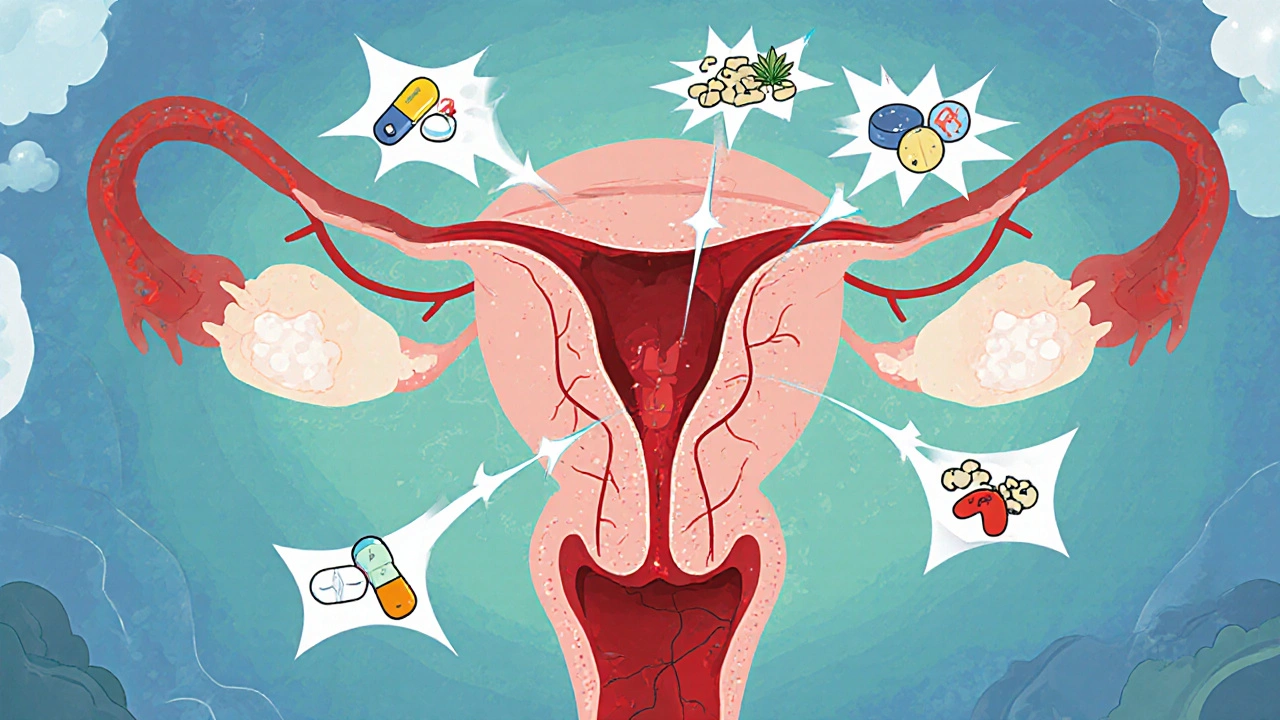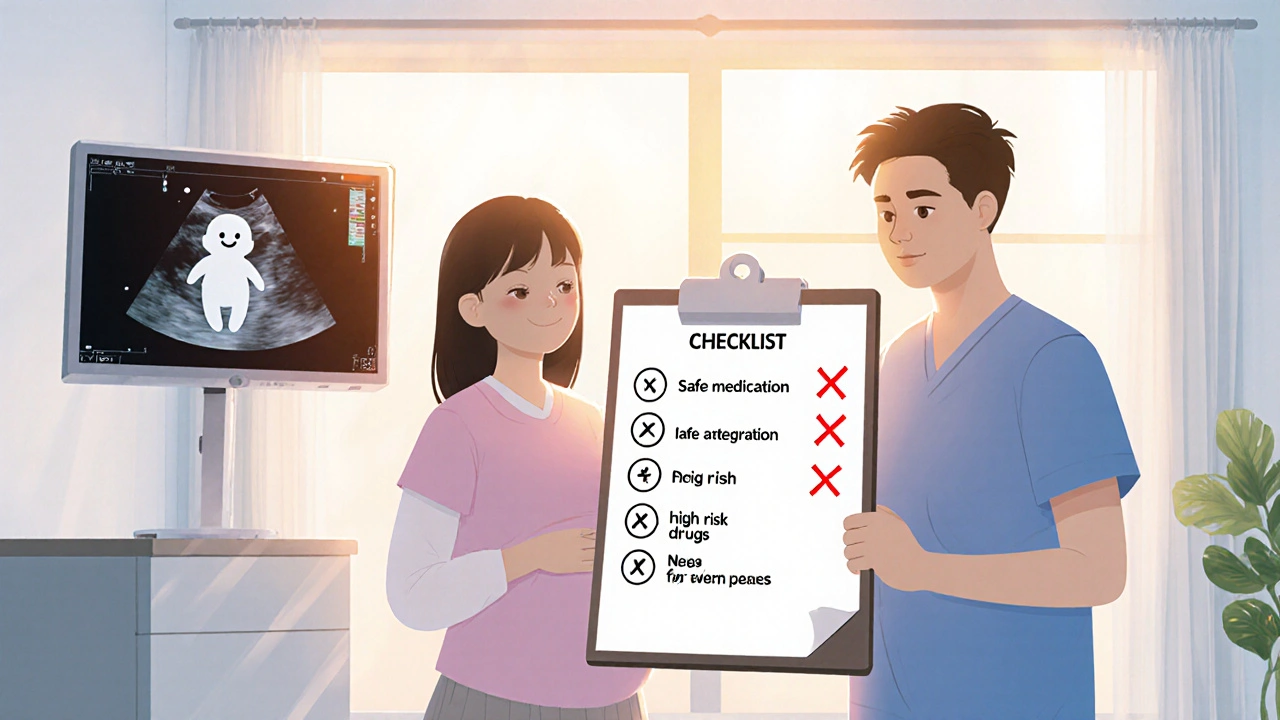When you’re expecting a baby, every pill, supplement, or over‑the‑counter remedy feels like a gamble. Some medicines are harmless, but a handful can interfere with the baby’s development and cause permanent defects. This guide breaks down how teratogenic drugs work, which substances you should avoid, and what steps you can take to protect both you and your unborn child.
Key Takeaways
- Teratogens pose the greatest risk in the first trimester, when organs are forming.
- Warfarin, carbamazepine, methotrexate, THC, and certain antiepileptics are proven teratogens.
- The FDA’s Pregnancy and Lactation Labeling Rule (PLLR) replaces the old A‑X categories and provides narrative risk information.
- A personalized risk‑benefit analysis, ideally involving an obstetrician, pharmacist, and the patient, is essential before starting any medication.
- Use a structured medication‑review checklist early in pregnancy to minimize anxiety and avoid preventable birth defects.
How Teratogens Damage a Developing Baby
Teratogenic medications are drugs that can cause structural malformations or functional disruptions while the fetus is growing. The vulnerability window is not the same throughout pregnancy:
- First trimester (weeks 1‑12): Organogenesis is in full swing. Exposure can lead to major structural birth defects, especially between days 15‑60 after conception.
- Second trimester (weeks 13‑26): The risk shifts to functional defects or minor structural issues. Some drugs can also affect placental efficiency during this period.
- Third trimester (weeks 27‑birth): Most drug effects influence organ function, cause neonatal withdrawal, or alter neurodevelopment.
Five primary mechanisms explain how medicines reach the fetus:
- Direct toxic damage to fetal cells.
- Indirect impact via reduced maternal blood pressure, which cuts placental blood flow.
- Altered placental transport, limiting oxygen and nutrients.
- Uterine muscle contractions that trigger preterm labor.
- No observable effect - the majority (60‑70%) of drugs fall here.
Understanding timing and mechanism helps clinicians decide whether a drug is worth the risk.
High‑Risk Drugs You Need to Know
Below is a concise snapshot of the most frequently cited teratogens, the trimester‑specific risks they carry, and the typical clinical scenarios that bring them into play.
| Medication | First Trimester Risk | Second Trimester Risk | Third Trimester Risk |
|---|---|---|---|
| Warfarin anticoagulant linked to fetal warfarin syndrome | Facial hypoplasia, skeletal stippling, optic atrophy (5‑30% incidence) | Optic atrophy, cataracts, microcephaly, fetal hemorrhage | Bleeding complications, neonatal hemorrhage |
| Carbamazepine anticonvulsant associated with neural tube defects | ~1% risk of spina bifida, vitamin K deficiency bleeding | Minor facial anomalies, growth restriction | Neonatal sedation, withdrawal |
| Methotrexate folate antagonist used for ectopic pregnancy and autoimmune disease | Neural tube defects (10‑20% increase), miscarriage | Fetal growth restriction | Hematologic toxicity, renal impairment |
| Cannabis (THC) psychoactive component of marijuana | Low birth weight (15‑20% rise), preterm birth (10‑15% rise) | Neurobehavioral changes, stillbirth risk | Potential hyperactivity, poor cognition in infancy |
| Acetaminophen common analgesic/antipyretic | Debated link to autism/ADHD (no proven causation) | Generally considered safe when used intermittently | Minimal risk; fever control still essential |
| Factor Xa inhibitors rivaroxaban, apixaban, edoxaban - oral anticoagulants | Insufficient human data; placental transfer confirmed | Same uncertainty; no reversal agent for pregnancy | Potential fetal bleeding, maternal hemorrhage |
These examples illustrate why a blanket “avoid all meds” rule isn’t practical; many conditions (e.g., epilepsy, hypertension) require treatment to protect both mother and baby.
The Regulatory Landscape: From A‑X to Narrative Labels
In 2015 the U.S. Food and Drug Administration (FDA) introduced the Pregnancy and Lactation Labeling Rule (PLLR) a narrative‑based labeling system that replaces the old letter categories. Instead of a single “Category D” label, each drug now carries three sections:
- Risk Summary: concise statement of known fetal risks.
- Clinical Considerations: advice on dose adjustments, monitoring, and alternative therapies.
- Data: source of evidence (human, animal, case reports).
Despite the shift, many clinicians still reference the legacy categories for quick mental checks. The American College of Obstetricians and Gynecologists (ACOG) professional body that issues evidence‑based guidance for pregnant patients publishes quarterly statements that often clarify gray areas-like its recent 2025 reaffirmation of acetaminophen’s safety for short‑term use.
These bodies agree on a core principle: always weigh the medication’s benefit against the potential fetal harm, and involve an interprofessional team whenever possible.

Risk‑Benefit Analysis: When Does Stopping a Drug Do More Harm?
Stopping a medication abruptly can trigger a flare‑up of the underlying disease, which sometimes poses a greater threat to the fetus than the drug itself. Here’s a quick decision framework you can run through with your provider:
- Identify the indication. Is the drug treating a life‑threatening condition (e.g., severe epilepsy, uncontrolled hypertension) or a mild symptom?
- Assess alternative therapies. Can a safer alternative be substituted? For example, low‑dose aspirin may replace warfarin for certain clotting disorders during pregnancy.
- Check the trimester. If you’re beyond week 12, some risks fade while others (like neonatal withdrawal) emerge.
- Consult the PLLR label. Look for specific language about “use only if the potential benefit outweighs risk.”
- Document the discussion. A written note helps both patient and provider stay aligned.
When the benefit clearly exceeds the risk, continue the medication but monitor the pregnancy more closely-often via targeted ultrasounds or fetal growth tracking.
Practical Steps for Expectant Parents
Feeling uneasy about a prescription? Follow this checklist before you swallow anything:
- Make a medication list. Include prescription drugs, over‑the‑counter meds, herbal supplements, and recreational substances.
- Bring the list to your first prenatal visit. Your obstetrician will pull the latest PLLR data and may consult a pharmacist.
- Use reputable resources. MotherToBaby, LactMed, and the FDA’s medication guide are curated, evidence‑based sites.
- Ask about monitoring. Some drugs require serial ultrasound assessments (e.g., warfarin‑exposed pregnancies often get detailed skeletal surveys).
- Plan for postpartum. Certain medications (like carbamazepine) need dose adjustments after delivery, especially if you’re breastfeeding.
Following a structured review not only reduces anxiety but also ensures that you and your care team are on the same page about potential risks.
Rare but Notable Historical Cases
The modern focus on teratogenic safety traces back to the Thalidomide a sedative that caused severe limb deformities in the early 1960s tragedy. Roughly 10,000 infants worldwide were born with phocomelia, prompting stricter drug‑approval processes worldwide. While thalidomide is now tightly controlled and used only for specific cancers and leprosy, its legacy underscores why pregnancy‑specific drug testing is non‑negotiable.

Future Directions in Pregnancy Pharmacology
Researchers are racing to add real‑world evidence to the sparse data pool. The FDA’s Sentinel Initiative aims to monitor 10 million patient records by 2026, vastly expanding the ability to spot rare teratogenic signals. Meanwhile, pharmacogenomics promises personalized risk scores-Dr. Christina Chambers of MotherToBaby predicts a 30‑40% boost in individualized predictions within five years.
Even with these advances, ethical limits mean most data still come from observational studies, case reports, or animal models. Keeping up with the latest guidelines, especially ACOG’s 2025 statements, remains the best defense for today’s expectant parents.
Quick Reference: Medication Safety Cheat Sheet
- Safe in all trimesters (when needed): Low‑dose aspirin, certain antihypertensives (e.g., labetalol), most antibiotics (penicillins, cephalosporins).
- Use with caution: Inhaled steroids, selective serotonin reuptake inhibitors (SSRIs) - weigh maternal mental health against modest fetal risk.
- Avoid in pregnancy: Warfarin, carbamazepine, methotrexate, THC, Factor Xa inhibitors, high‑dose vitamin A.
Remember, pregnancy medication safety isn’t about a universal blacklist; it’s a balanced conversation with your healthcare team.
Frequently Asked Questions
Can I take acetaminophen throughout pregnancy?
ACOG’s 2025 guidance says short‑term, intermittent use for pain or fever is safe. The CDC notes a theoretical link to neurodevelopmental issues when used chronically, but no causal proof exists. If you need regular pain relief, discuss alternative options with your provider.
What should I do if I accidentally took a teratogenic drug before knowing I was pregnant?
Contact your OB‑GYN or a teratology information service (like MotherToBaby) immediately. Early consultation can guide targeted ultrasound screening and, if appropriate, discuss antidotes or medication switches.
Are herbal supplements safe in pregnancy?
Many herbs lack rigorous safety data. “Safe” labels often rely on anecdotal evidence. Always ask your provider before starting any supplement; some (e.g., black cohosh, high‑dose ginseng) have known uterine‑stimulating effects.
How does the PLLR differ from the old FDA pregnancy categories?
The PLLR provides a narrative risk summary, clinical considerations, and data sources instead of a single letter. This gives clinicians more context about study quality and specific timing of the risk.
Is it ever okay to stay on warfarin during pregnancy?
In rare cases where the mother has a mechanical heart valve with high thrombosis risk, low‑molecular‑weight heparin may not provide adequate protection. A specialist team may decide to continue warfarin with intensive fetal monitoring, but this is exceptional and requires informed consent.


ahmed ali
Okay, so let me break this down because most people just skim the headlines and think all meds are either totally safe or outright poison. First off, the placenta is a selective barrier, but it’s not an impenetrable wall – a lot of small‑molecule drugs cross it with ease, especially in the first trimester when the fetal blood‑brain barrier is basically non‑existent. Second, timing matters more than you realize; exposure between days 15‑60 can cause major organ malformations, while later exposure tends to affect function more than shape. Third, the old A‑X categories are basically relics, so leaning on the newer PLLR narrative is the only way to get context about dose, timing, and the quality of the underlying evidence. Fourth, warfarin isn’t just a blood thinner – it can cause facial hypoplasia, skeletal stippling, and even optic atrophy if you’re unlucky in weeks 5‑8, so you’re better off switching to low‑molecular‑weight heparin unless you have a mechanical heart valve that can’t tolerate anything else. Fifth, carbamazepine’s risk of neural tube defects is roughly 1 % – that’s not zero, and folate supplementation can only mitigate it so far, so discuss alternatives like levetiracetam with your neurologist. Sixth, methotrexate is a folate antagonist, which means it directly interferes with DNA synthesis; that’s a recipe for neural tube defects and miscarriage, so it’s off‑limits the minute you suspect you might be pregnant. Seventh, THC’s impact on fetal growth isn’t just about low birth weight; chronic use also nudges neurobehavioral outcomes in ways we’re still untangling, so it’s safest to quit before conception. Eighth, acetaminophen is a special case – the data are noisy, and while there’s no proven causation for autism, chronic high‑dose use still raises eyebrows, so limit it to intermittent doses. Ninth, factor Xa inhibitors have almost no human data, which is a red flag – if you’re on rivaroxaban or apixaban, you need a specialist to manage a bridge therapy. Tenth, remember that abrupt discontinuation of a medication can trigger a flare‑up that harms the fetus more than the drug itself, so always taper under medical supervision. Eleventh, a multidisciplinary team – OB‑GYN, pharmacist, and maybe a teratology information service – can run a risk‑benefit matrix that’s personalized to your condition. Twelfth, keep a running medication list and bring it to every prenatal visit; this simple habit reduces anxiety and prevents accidental exposures. Thirteenth, consider targeted ultrasounds if you’ve been on a known teratogen during organogenesis – a detailed anatomy scan can catch many issues early. Fourteenth, postpartum, watch for drug‑specific weaning protocols, especially if you’re breastfeeding; carbamazepine and warfarin both need dose adjustments. Fifteenth, stay tuned to evolving guidelines – ACOG just updated its stance on low‑dose aspirin and it's now a first‑line prophylaxis for pre‑eclampsia in high‑risk patients. Finally, pregnancy isn’t a time to go into therapeutic nihilism; it’s about balancing maternal health needs with fetal safety, and that balance is built on solid evidence, not myth.
Deanna Williamson
From a pharmacovigilance perspective, the risk matrix you outlined aligns with current FDA post‑marketing surveillance data, especially regarding warfarin and carbamazepine. The temporal correlation between organogenesis and structural anomalies is well‑documented in the teratology literature, reinforcing the importance of trimester‑specific counseling. Moreover, the limited human data on factor Xa inhibitors underscore a gap that registry studies aim to fill, as highlighted in recent ACOG statements. Your emphasis on multidisciplinary review reflects best practice standards, reducing both maternal and fetal adverse events. Finally, the recommendation for targeted ultrasounds is supported by meta‑analyses showing increased detection rates for major malformations when imaging is performed at 18–22 weeks.